
On the eve of November 8, 2016 Prime Minister Narendra Modi addressed the country and in a shock announcement said currency notes of Rs. 1000 and Rs. 500 would not be considered as legal tender any more. Modi called upon fellow Indians to participate in this ‘Mahayagna’ against the menaces of corruption – black money, fake notes and terrorism.
In this fight against corruption, black money, fake notes and terrorism, in this movement for purifying our country, will our people not put up with difficulties for some days? I have full confidence that every citizen will stand up and participate in this ‘mahayagna’. - PM Modi.
With time the narrative around demonetisation has developed to include digitisation and formalization of economy into its goals.
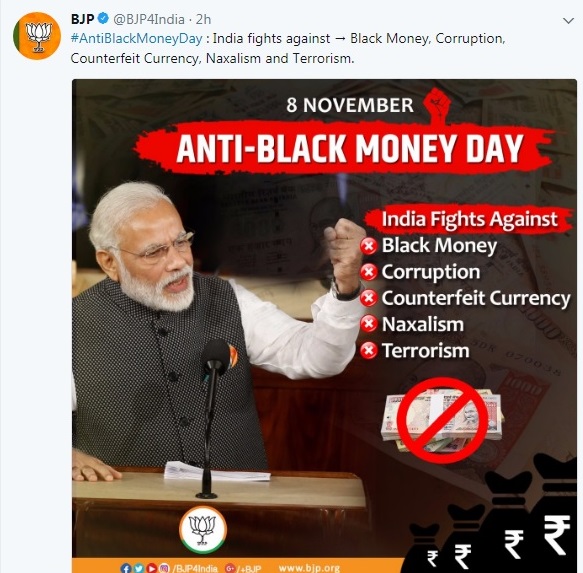
One year on BOOM looks at what has demonetisation done in terms of achieving the 3 original goals of - 1) Eradicating black money 2) Removing counterfeit currency 3) Curbing terror funding
1) BLACK MONEY – No official estimate on black money that entered banking system through deposits post demonetisation. However, government reminds that all deposits are not legitimate and Rs 2.89 lakh crore is under scanner.
As of June 30, 2017, 99% of demonetized currency notes (Rs 500 and Rs 100) have returned to the RBI. The estimated value of currency in circulation in these notes was at Rs 15.44 lakh crore on November 8, 2016 of which Rs 15.28 lakh crore have returned to the banking system as of June 30, 2017. Rs. 16,000 crore that did not return to the RBI is only 1% of the value of demonetized currency.

There is no official estimate on the black money that was extinguished or which got legitimized by depositing in banks post demonetisation. RBI informed a parliamentary panel in September 2017 that there was ‘no information’ in this regard.
However, deposits in 13.33 lakh accounts amounting to Rs 2.89 lakh crore is under income tax investigations as part of the 'Operation Clean Money' launched in January 2017.
Apart from these deposits, 1100 searches and surveys during the 2 months of the demonetisation drive – mid November 2016 to January 10, 2017 - has led to the detection of Rs. 5400 crore unaccounted income and seizure of valuables worth Rs. 610 crore. Of the seized valuables, Rs. 513 crore was in cash and Rs 110 crore in new currency notes.
Updated data shows that between November 2016 and May 2017, undisclosed income of Rs. 17526 crore has been detected and Rs. 1003 crore has been seized.
Despite the hype around demonetisation, the government maintains that detection of black money is an on-going process and demonetisation is only one such measure. Finance Minister Arun Jaitley said in August, 'the fact that money got deposited in banks doesn’t make it legitimate money'.
2) TERROR FUNDING – Data does not suggest a clear decline in terror activities.
The government claims that there is a positive impact on terrorism post demonetisation. The Ministry of Home Affairs in a Lok Sabha question said,
Since illegally held cash forms the major chunk of terrorist funding, after the demonetisation, most of the cash held with the terrorists turned worthless.
Though month wise data on terror incidents is not available, data on fatalities due to terror violence in J& K and areas of Left Wing Extremism (LWE) show that terrorism is not on the decline. In the absence of government data, data from South Asian Terrorism Portal - a website on terrorism in South Asia- has been used.
Terrorism in Jammu & Kashmir
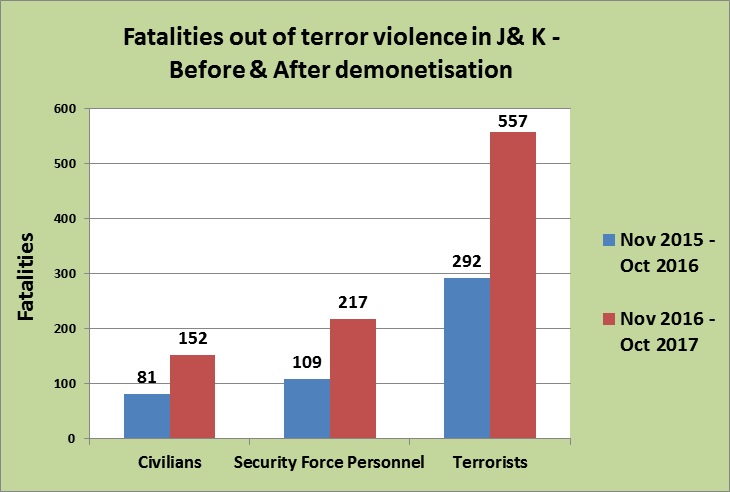
Source : South Asian Terrorism Portal
A comparison of fatalities 1 year post demonetisation and 1 year prior to demonetisation shows –
- 88% jump in civilian deaths to 152
- 99% jump in deaths of security force personnel to 217
- 91% jump in deaths of terrorist to 557
Along with terror incidents, the government also claimed that stone pelting incidents have dropped since demonetisation.
"Earlier, there were rates: Rs 500 for stone pelting (on security forces in Kashmir) and Rs 1,000 for doing something else. PM has brought terror funding to zero’, said former Defence Minister Manohar Parrikar
“The reduction in incidences of stone pelting, protests in J&K and naxal activities in Left Wing Extremism (LWE) affected districts are also attributed to the impact of demonetisation as these miscreants have run out of cash,” said finance MinisterArun Jaitley.
Data show that 1067 incidents of stone pelting was recorded in Jammu & Kashmir between November 2016 and August 2017. And, the transient dip observed between November 2016 to January 2017 cannot be attributed invariably to demonetisation as stone pelting was already at a steady decline since August 2016, even before demonetisation was announced.
Lok Sabha data shows that stone pelting incidents saw a sudden surge in July 2016. This was during the unrest in Jammu & Kashmir after the death of Burhan Wani, a militant leader, in July 2016.
Stone pelting incidents in Kashmir Valley April 2016 to March 2017
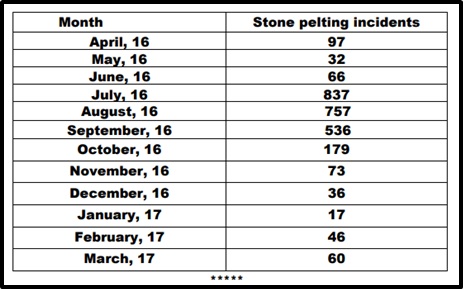 Screenshot from Lok Sabha Question
Screenshot from Lok Sabha Question
More recent data accessed by Factchecker.in on stone pelting incidents in Jammu & Kashmir from J&K Police Department is as follows:
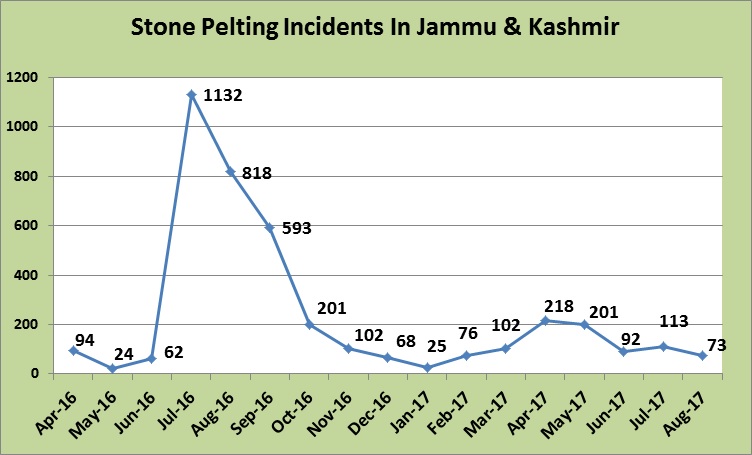
Source: Factchecker
Note: The difference between data accessed by Factchecker and of Lok Sabha could be because the former is of Jammu and Kashmir and the latter of Kashmir Valley only.
Post the death of militant leader Burhan Wani by Indian security forces, stone pelting was already at a steady decline from 1132 (July 16) to 818 (Aug 16) to 593 (Sept 16) to 201 (Oct 16) before it reached 102 (Nov 16) and 68 (Dec 16) post demonetisation. Stone pelting further saw an increase in April 2017 to 218.
Thus, data does not show a clear decline in stone pelting. Nor does it suggest a clear link between decrease in stone pelting (between Nov 16 to Jan 17) to demonetisation.
Terrorism in Left Wing Extremist Areas
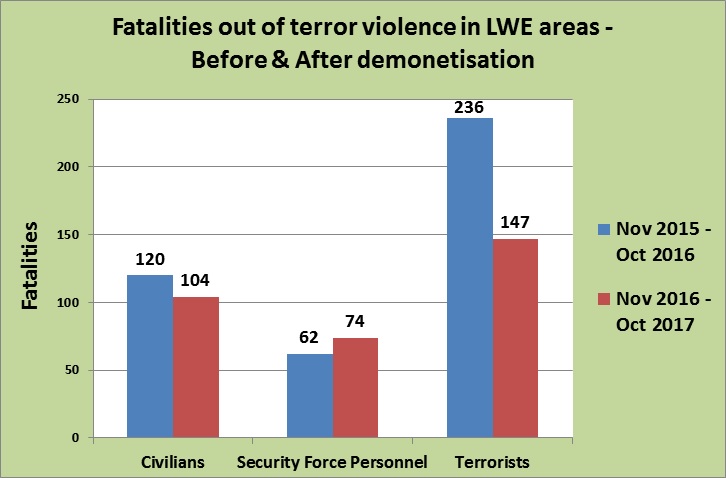
Source : South Asian Terrorism Portal
A comparison of fatalities 1 year post demonetisation and 1 year prior demonetisation shows –
- 13 % decline in civilians deaths to 104
- 19% jump in Security force deaths to 74
- 38% decline in terrorists deaths to 147
3) COUNTERFEIT CURRENCY – 837 pieces of fake currency notes of new Rs 2000 and Rs 500 were found. The notes were of low quality, claims the government.
As of new Indian currency notes, 638 pieces of Rs 2000 and 199 pieces of Rs 500 have been found since its release in November 2016 to March 2017, according to RBI’s annual report. This amounts to a face value of Rs 13.75 lakhs.
Updated data accessed from Lok Sabha questions show that 9254 FICNs of new Rs 2000 have been seized from bordering states of the country between Nov 9, 2016 to August 7, 2017. This amounts to a face value of Rs 18.5 lakhs.
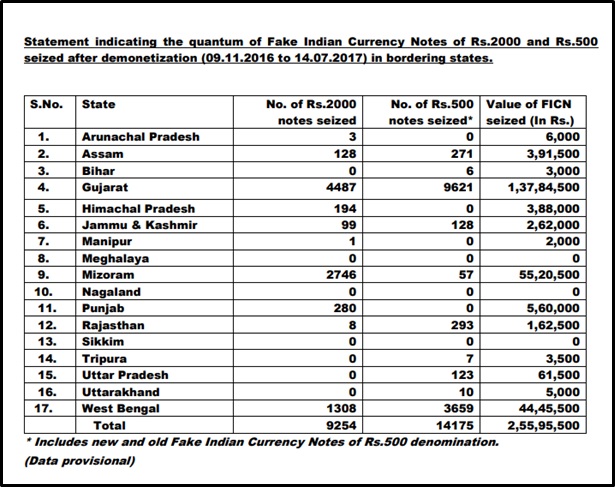 Screenshot from Lok Sabha Question
Screenshot from Lok Sabha Question
Ministry of Finance has stated in Lok Sabha in July 2017 that all the counterfeit currencies seized were of low quality suggesting that it has become more difficult to print counterfeit notes.
However, the Directorate of Revenue Intelligence in the recent months have found 'high quality' fake notes of the new denominations with a face value of Rs 35 lakh. Eight out of seventeen security features have been compromised in these notes as reported by Indian Express.
Fake Indian Currency Notes (FICN) of demonetised Rs 500 and Rs 1000 are as follows
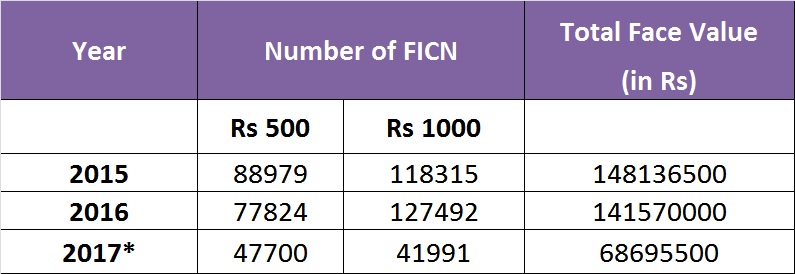
Source : Lok Sabha Question
Note: 2017 data upto July 17, 2017